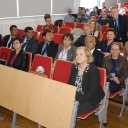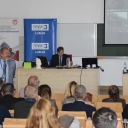On October 16, 2018, the Lublin University of Technology hosted an international scientific conference “Information Technology in Cultural Heritage Management / IT in Cultural Heritage Management (IT-CHM)” organised by the Institute of Computer Science of the Lublin University of Technology, the Zamoyski Museum in Kozłówka and the Lublin Department of the Polish Information Processing Society. The conference was granted honorary patronage by His Magnificence prof. dr hab. inż. Piotr Kacejko – Rector of the Lublin University of Technology, Marshal of the Lublin Province, Lublin Scientific Society and the “European Year of Cultural Heritage”. The media patronage was provided by: TVP 3 Lublin, the Forum Akademickie monthly and Polish Radio Lublin.
The participants of the conference were several dozen employees from many museums in the Lublin and Subcarpathian Provinces, directors of the main museums in Samarkand (Uzbekistan): Registan Ansamble, Afrasiab Museum, Mirzo Ulugbek Museum, Gur-e Amir Mausoleum, Khodja Doniyor Mausoleum, as well as research workers at Samarkand State University, National University of Uzbekistan and the Institute of History at the Uzbekistan Academy of Sciences, as well as employees of the archaeological company “Archee” and cultural institutions from Lublin, e.g. the Grodzka Gate Centre.
The conference aimed to provide knowledge about the use of information technology in management in the field of cultural heritage, deepening the contacts of Polish museum workers with representatives of Samarkand museums and provoke discussion of Lublin museum and archaeological environments with representatives from Samarkand. The programme included 15 papers presented by speakers from Poland and abroad. The first group of talks concerned discussing existing IT systems, standards and software enabling management of selected areas of cultural heritage and museology. In the next group guests from Samarkand presented the specifics of their mausoleum museums along with a discussion of the collections stored there, taking into account the computer techniques used so far. The third group included presentations of employees of the Institute of Computer Science. They concerned the presentation of effects from the 1st and 2nd expedition of the Lublin University of Technology to Central Asia, in order to carry out three-dimensional archiving of artefacts from the collection of museum collections using the technology of “reverse engineering”, 3D scanning of large architectural objects and ways of presenting their digital representation in the Internet and virtual world reality (VR), as well as a display of 3D technology dedicated to museology and archeology held by the laboratory ‘Lab 3D’ of the Institute of Computer Science. In the last group there were presentations of excavations at Świętoduska street, realised in the 2017 season by the company “Archee”, taking into account the 3D computer technologies used for archiving the state of excavations. Visitors from Uzbekistan also presented issues concerning the historical heritage of the Silk Road on the example of Samarkand, with the possibility of preparing a future digital exhibition available in the Internet, using 3D models developed by employees of the Institute of Computer Science. The last paper from this group concerned the intangible cultural heritage, i.e. the study of the fate of Poles deported to Uzbekistan during the Second World War.
Complementing the conference for the guests from Samarkand and Tashkent was the organisation over the next days a mini workshop in the laboratory ‘Lab 3D’, presenting 3D computer technologies which can be successfully used for archiving and visualising museum and archaeological objects. Structural light scanners were presented (Artec Eva and Spider; Faro Focus X330 laser scanner, 3D printers working in FFF technology – MarketBot Z18 and SLS-DWS 020X, specialised 3D zSpace monitor, VR helmets: Oculus Rift DK2, Samsung VR Gear and a system for human-computer Leap Motion communication. A practical complement to the whole was a visit prepared by Anna Fic-Lazor, director of the Zamoyski Museum in Kozłówka.
The conference organised is a visible testimony that multidisciplinary and even inter-disciplinary research is carried out at the Lublin University of Technology, combining culture, museology and archeology with technical sciences. It is also a significant contribution by the University towards the so-called 3rd mission of universities, or their contribution to the development of society in Poland and the wider world.
Jerzy Montusiewicz, Marek Miłosz


Related